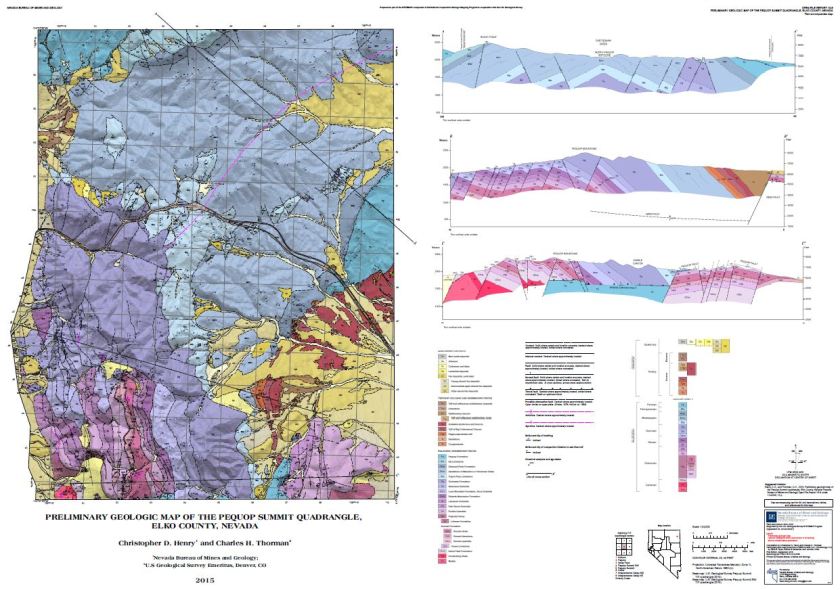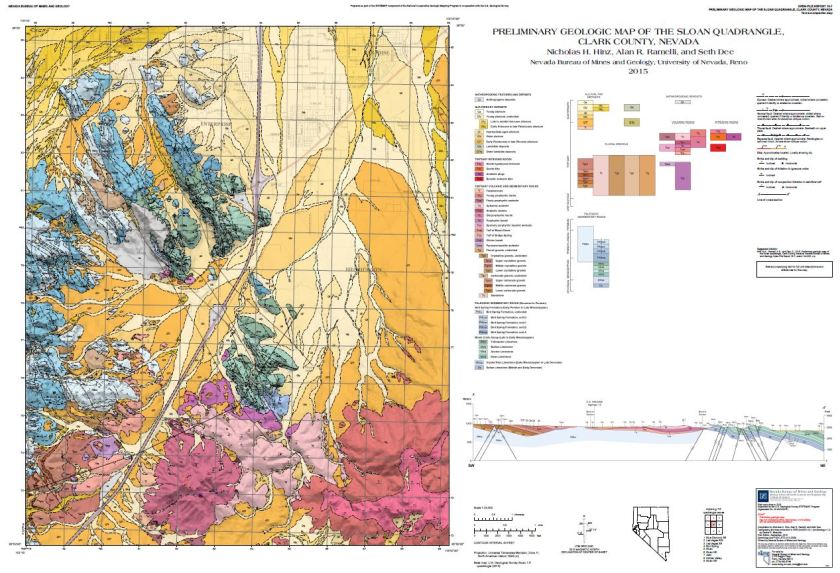 Preliminary Geologic Map of the Kinsley Mountains, Elko and White Pine Counties, Nevada
Preliminary Geologic Map of the Kinsley Mountains, Elko and White Pine Counties, Nevada
Authors: John L. Muntean, Seth Dee, Tyler J. Hill, Randall L. Hannink, Moira Smith, Gene Urie, and Ken Raabe
Year: 2017
Series: Open-File Report 2017-07
Version: first edition, September 2017; supersedes Open-File Report 15-9
Format: plate: 41 x 54.5 inches, color; text: 5 pages, b/w
Scale: 1:12,000
View/Download/Purchase:
This detailed geologic mapping of the Kinsley Mountains in eastern Nevada investigates the time-space relationships between an Eocene intrusive complex centered on a granitic stock, proximal intrusion-related polymetallic skarn and carbonate replacement mineralization, disseminated Carlin-style gold deposits 3 km north of the stock, Eocene magmatism, and Eocene through Quaternary faulting. Previous detailed mapping of the northern Kinsley Mountains by geologists of Pilot Gold was compiled, field checked, and refined, along with new mapping during the summers of 2015 and 2017. Pilot Gold is exploring for more Carlin-style mineralization in the center of the range and map area, where gold ore was previously mined in the late 1990s. The mapping revealed: 1) a significant amount of extensional faulting occurred prior to Eocene magmatism and mineralization, similar to what NBMG mapping documented recently in the Eureka mining district. Eocene intrusions cut faults or fill faults, and Eocene volcanic rocks unconformably overlie Paleozoic rocks as old as Ordovician and as young as Permian, 2) Eocene dikes, gossans, and quartz veins, and jasperoid formation are focused within a 1-km-wide corridor that extends 3 km northward from the stock to the area of carbonate-hosted Carlin-like gold deposits, where dikes in drill core have locally high gold grades, 3) significant Eocene extension is demonstrated by a southwest-dipping fault that dropped Permian rocks against metamorphosed and mineralized Cambrian rocks proximal to the Eocene stock; the fault is overlapped by Eocene volcanic rocks that are a few million years younger than the stock, suggesting the intrusive complex was rapidly exhumed nearly 3 km, and 4) detailed mapping of the Quaternary range front fault on the east side of the mountains demonstrates offset of alluvial-fan deposits of likely mid-Pleistocene age with no faulting in younger Quaternary deposits.
This map was prepared as a part of the STATEMAP component of the National Cooperative Geologic Mapping Program in cooperation with the U.S. Geological Survey under STATEMAP award number G16AC00186, 2017.

 Preliminary Geologic Map of the North Half of the Independence Valley NW Quadrangle and the Adjacent Part of the Independence Valley NE Quadrangle, Elko County, Nevada
Preliminary Geologic Map of the North Half of the Independence Valley NW Quadrangle and the Adjacent Part of the Independence Valley NE Quadrangle, Elko County, Nevada Preliminary Geologic Map of the Boulder City NW Quadrangle, Clark County Nevada
Preliminary Geologic Map of the Boulder City NW Quadrangle, Clark County Nevada

